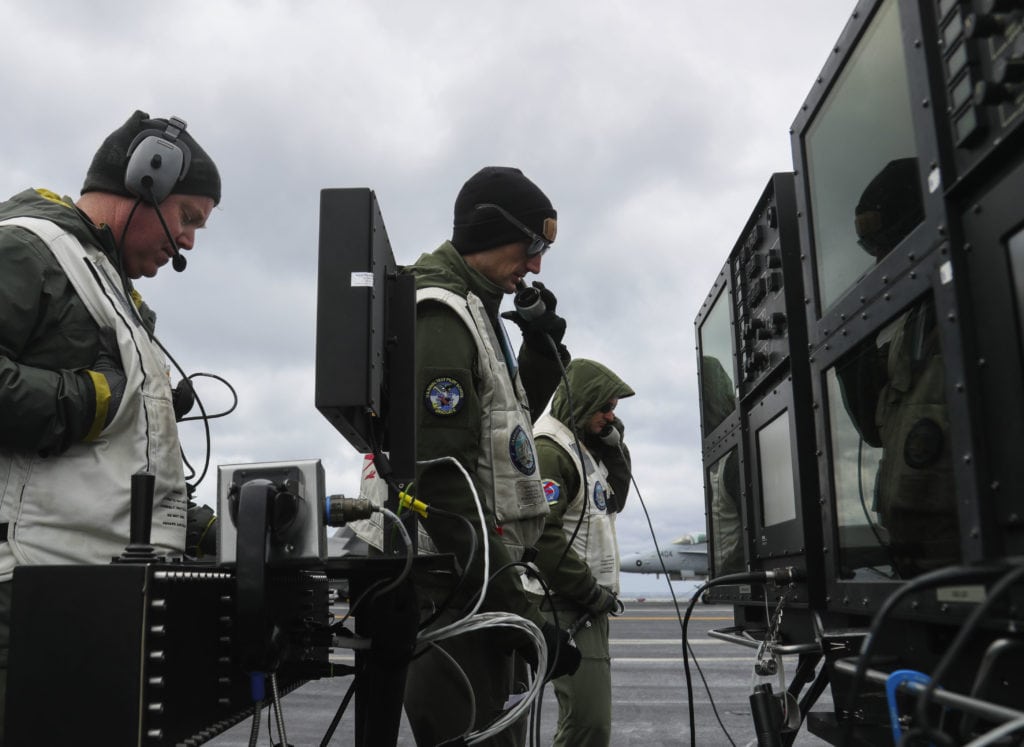
Landing signal officers aboard the USS Abraham Lincoln aircraft carrier. Photo by Josue Escobosa courtesy of the U.S. Navy
The USS Abraham Lincoln is testing for the first time a system designed to remotely land aircraft on a carrier.
According to the U.S. Navy, the system, called aircraft terminal approach remote inceptor (ATARI), was successfully demonstrated during a touch-and-go on an aircraft carrier while conducting carrier qualifications and flight testing aboard the Abraham Lincoln. ATARI gives landing signal officers (LSOs) the ability to take over and maneuver aircraft during recovery operations.
“I was really impressed with LSO’s ability get me to touch down,” said Lt. John Marino, a carrier suitability pilot from the “Salty Dogs” of air test and evaluation squadron 23 and the first pilot to land on a flight deck using ATARI. “The conditions were really varsity, and it was really impressive the system worked the way it did. On a calm day, it would have been a little bit boring, but this was definitely more challenging.”
Developed by U.S. Naval Air Systems Command (NAVAIR), ATARI was originally tested on a Learjet in 2016, performing shore-based low approaches. In 2017, F/A-18s were fitted with the technology and, after extensive testing, VX-23 was confident enough to try the system at sea.
LSOs are capable of taking over an aircraft from up to five miles away using the ATARI. The system demonstrates a potential method for recovering an unmanned aircraft system (UAS) using the LSO’s ability to observe and fix glideslope and lineup errors.
“We don’t have unmanned carrier-based vehicles in the fleet today, but they are coming soon,” said NAVAIR engineer Dan Shafer. “This is a potential alternative landing method and our system performed well.”
Much like its namesake, ATARI uses a joystick to control a UAS or, in this case, an F/A-18 outfitted with the system with a safety pilot sitting in the cockpit. The LSOs use the joysticks to make corrections and safely land the aircraft on the flight deck.
“We took the guy who’s flying the aircraft and we moved him to the LSO platform,” said Buddy Denham, a senior engineer at NAVAIR and creator of ATARI. “You’re effectively using little joystick controllers to guide a 40,000-pound airplane, and it’s almost like you’re playing a video game.”
Prior to landing, the aircraft first had to perform three wave-offs to ensure all conditions were safe and the system could indeed take over the aircraft while at sea. On the fourth approach, the system engineers and LSOs felt comfortable doing touch-and-go.
“The deck was pitching significantly and yawing and rolling,” said Denham. “It was particularly difficult to land that day, and we showed it’s possible to use this system even when the conditions aren’t ideal.”
The ATARI testing was conducted over the course of two days in conjunction with carrier qualifications. Though not currently slated for fleet-wide implementation, the successful test gives it the potential for future application. The ATARI engineers will analyze the data collected aboard Abraham Lincoln and make adjustments for further at-sea testing.